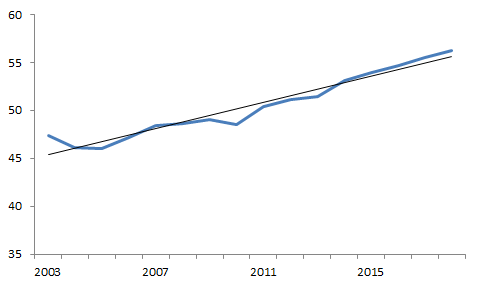
The increasing age of RTM directors
The average age of an RTM director has increased by 8 years over the past 15 years. If things were to continue at this same rate the average age by 2030 will be almost 60 years old and they will need different things from their buildings and the agents who manage them.
As well as challenging the way managing agents operate, there will also be opportunities to provide new services.
Average age of an RTM director since 2004

The average age of an RTM director has been rising steadily since 2004. There has been some variability - particularly prior to and following the 2008 financial crash. Despite this variance in the vast majority of locations we reviewed, we found this similar pattern of increasing ages.
By going further into the numbers, we can see that this trend is made from two components.
The average age of new RTM directors per year since 2004

The average age of directors of buildings who first took an RTM in 2004

By analysing this in a bit more detail we can see two changes happening:
- The average age of a new RTM director is variable but increasing
- The average age of an RTM director of an existing building is steadily increasing
The rate of new RTM growth is increasing every year (see our monthly RTM benchmarks). On average, each year a new RTM director will be 6 months older than the last year – which likely reflects the increasing average age of owners of leaseholds.
More clearly seen is how the average age for existing buildings is steadily increasing - this is despite a reasonable amount of churn (of around 15 % every 5 years on average across all buildings reviewed).
This indicates that buildings with older RTM arrangements will tend to have older directors. And when they are replaced, they are replaced by directors of the same age or older.
How this reflects the wider societal trends
These trends are in-line with both the pattern of an aging population in the UK and the increasing age of first-time buyers.
Figures from Age UK show how by 2033, half of UK households will be headed by someone over retirement age, from a current level of third*.
What the numbers show is that this effect is even more exaggerated within apartment blocks and leasehold estates, with around a 12% of RTM directors over retirement age, which has grown from 8% since 2004.
Implications
If these trends continue, there are a number of long-term changes to the services provided to each building.
The analysis shows that the residents and (more importantly) the decisions makers in buildings are getting older and will demand services in-tune with their demographic. Changes will likely be around:
- Demand for new services – particularly those related to medical needs
- Increased emphasis on service continuity (for example with lift services) where facilities need to in working condition for 100% of the time
- Changes in communication methods and styles – possibly against online and automated forms of communications
Managing agents that are able to provide these services to the required level will likely be the top growing
Historical datasets
Methodology
We use a number of data sets generated from our operations and public records in order to create initial estimates and verify our analysis. If you would like to discuss this further, please get in touch at data@juxtablock.com

